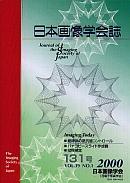All issues

Volume 39 (2000)
- Issue 4 Pages 390-
- Issue 3 Pages 173-
- Issue 2 Pages 66-
- Issue 1 Pages 3-
Volume 39, Issue 1
Displaying 1-6 of 6 articles from this issue
- |<
- <
- 1
- >
- >|
-
Yasunori KOBORI, Takashi OMATA, Tetsuo NAKANO, Yuuichi TAKANO2000Volume 39Issue 1 Pages 3-12
Published: 2000
Released on J-STAGE: June 06, 2006
JOURNAL FREE ACCESSA video printer using thermal dye transfer method is suitable for high quality printing. Recently this type of video printers is faster in printing time and lower cost, so there appears some problems about heat regeneration and optical density gap called ghost. Especially the ghost appears in the edge of vertical bands of high density, because of change of current rush to the thermal head. Heat regeneration in the thermal head makes a color tailing behind of high-density printing.
For ghost problem, we have investigated the line resistance of the thermal head and calculated voltage drop and power loss. This voltage drop is nearly proportional to the number of active pixels. So we compensated the energy loss of the thermal head with the extra pulse length of strobe pulse.
Heat regeneration is a big problem for thermal printers because of a dull in the tailing edge of high-density printing. Usually it is very difficult to control heat regeneration precisely. We have made the printing data compensated according to the regenerative function, that presents the predictive value of printing density. This regenerative function is calculated from previous values of this function in each pixel. The input data is modified to the printing data according to the compensation value.View full abstractDownload PDF (2238K) -
Kazuaki SUKATA2000Volume 39Issue 1 Pages 13-16
Published: 2000
Released on J-STAGE: June 06, 2006
JOURNAL FREE ACCESSA model for two-component developers, where the charging process is an equilibrium of the transfer of charge between a toner and a carrier, was refined, giving the relations of the toner-carrier mass ratio (mt/mc=Ct) to the carrier charge-to-mass ratio (qec) and to the apparent tribocharging-rate constants (kobsd):
1/qec=-1/qlimt[(k-1st/k1sc)+1/Ct] and kobsd=k1[1+(k-1st/k1sc)Ct],
where qlimt is the limiting charge (the tribocharge when no charge transfers to the toner from the carrier, k-1=0), st and sc are specific surface areas of the toner and the carrier, respectively, kobsd is the apparent tribocharging-rate constant, and k1 and k-1 are pseudo-first order rate constants of the transfer of charge from the toner to the carrier and from the carrier to the toner, respectively.
These relationships were confirmed to apply in our experiment using a model toner: The values of qlimt and k1sc/k-1stobtained from the two equations were in good agreement with those obtained previously from the relationship between the toner charge-to-mass ratio (qet) and mt/mc=Ct. Furthermore, the 1.0% CCA toner-to-0.5% CCA toner ratios in k1 and k-1 were not only comparable with each other but also with the CCA weight ratio and with the ratio of the frequency factors, Z, for the two toners estimated from the Arrhenius equation. These results show that our model consistently joins the dynamic and the static states and is valid.View full abstractDownload PDF (533K) -
Tatsuro KITAURA2000Volume 39Issue 1 Pages 18-24
Published: 2000
Released on J-STAGE: June 06, 2006
JOURNAL FREE ACCESSDownload PDF (1521K) -
Satoru TAKAKI2000Volume 39Issue 1 Pages 25-29
Published: 2000
Released on J-STAGE: June 06, 2006
JOURNAL FREE ACCESSDownload PDF (672K) -
Yoshitomo MASUDA, Koji TAKAGI2000Volume 39Issue 1 Pages 30-35
Published: 2000
Released on J-STAGE: June 06, 2006
JOURNAL FREE ACCESSDownload PDF (758K) -
Hisao OKADA, Shinji ÕTANI2000Volume 39Issue 1 Pages 36-39
Published: 2000
Released on J-STAGE: June 06, 2006
JOURNAL FREE ACCESSDownload PDF (444K)
- |<
- <
- 1
- >
- >|